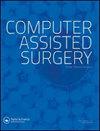在导航辅助微创腰椎融合手术中,骨附件是否需要作为动态参考系?
IF 1.9
4区 医学
Q3 SURGERY
引用次数: 5
摘要
摘要本研究旨在比较传统髂后上棘(PSIS)固定和经皮固定动态参考系(DRF)在微创经椎间孔腰椎融合术(MIS TLIF)中导航辅助经皮椎弓根螺钉插入的准确性。这是一项前瞻性随机临床研究。在2016年5月至2017年11月期间,100名接受MIS TLIF的患者被随机分为骨固定组(采用PSIS固定DRF)和皮肤固定组(使用皮肤固定的DRF)。椎弓根螺钉在导航引导下插入,使用Ziehm三维荧光透视导航系统在手术中获得的计算机断层扫描(CT)数据。术中最后一次扫描立即检查螺钉位置。通过复杂的计算机断层扫描方案评估螺钉放置的准确性。两组患者的人口统计数据相似。共有512枚椎弓根螺钉植入腰椎。有2名中度(2-4 mm)椎弓根穿孔。骨固定DRF和皮肤固定DRF的准确性无显著差异。没有明显的手术相关并发症。皮肤固定DRF在MIS TLIF中使用术中3D图像引导导航,在椎弓根螺钉插入中提供与骨固定DRF相似的准确性。皮肤固定DRF不仅是一种替代方法,而且还省去了用于骨附着的单独切口伤口。本文章由计算机程序翻译,如有差异,请以英文原文为准。
Is bony attachment necessary for dynamic reference frame in navigation-assisted minimally invasive lumbar spine fusion surgery?
Abstract This study aimed to compare the accuracy of navigation-assisted percutaneous pedicle screw insertions between traditional posterior superior iliac spine (PSIS) fixed and cutaneously fixed dynamic reference frame (DRF) in minimally invasive surgery of transforaminal lumbar interbody fusion (MIS TLIF). This is a prospective randomized clinical study. Between May 2016 and Nov 2017, 100 patients who underwent MIS TLIF were randomly divided into bone fixed group (with PSIS fixed DRF) and skin fixed group (with cutaneously fixed DRF). The pedicel screws were inserted under navigational guidance using computed tomography (CT) data acquired intraoperatively with a Ziehm 3-dimensional fluoroscopy-based navigation system. Screw positions were immediately checked by a final intraoperative scan. The accuracy of screw placement was evaluated by a sophisticated computed tomography protocol. Both groups had similar patient demographics. Totally Five-hundred Twelve pedicle screws were placed in the lumbar spine. There were 2 moderate (2–4 mm) pedicle perforations in each group. The accuracy showed no significant difference between bone fixed and skin fixed DRF. There were no significant procedure-related complications. The skin fixed DRF provides similar accuracy in pedicle screw insertions with bone fixed DRF using intraoperative 3D image guided navigation in MIS TLIF. Skin fixed DRF not only serves as an alternative method but also saves a separate incision wound for bony attachment.
求助全文
通过发布文献求助,成功后即可免费获取论文全文。
去求助
来源期刊

Computer Assisted Surgery
Medicine-Surgery
CiteScore
2.30
自引率
0.00%
发文量
13
审稿时长
10 weeks
期刊介绍:
omputer Assisted Surgery aims to improve patient care by advancing the utilization of computers during treatment; to evaluate the benefits and risks associated with the integration of advanced digital technologies into surgical practice; to disseminate clinical and basic research relevant to stereotactic surgery, minimal access surgery, endoscopy, and surgical robotics; to encourage interdisciplinary collaboration between engineers and physicians in developing new concepts and applications; to educate clinicians about the principles and techniques of computer assisted surgery and therapeutics; and to serve the international scientific community as a medium for the transfer of new information relating to theory, research, and practice in biomedical imaging and the surgical specialties.
The scope of Computer Assisted Surgery encompasses all fields within surgery, as well as biomedical imaging and instrumentation, and digital technology employed as an adjunct to imaging in diagnosis, therapeutics, and surgery. Topics featured include frameless as well as conventional stereotactic procedures, surgery guided by intraoperative ultrasound or magnetic resonance imaging, image guided focused irradiation, robotic surgery, and any therapeutic interventions performed with the use of digital imaging technology.
 求助内容:
求助内容: 应助结果提醒方式:
应助结果提醒方式:


